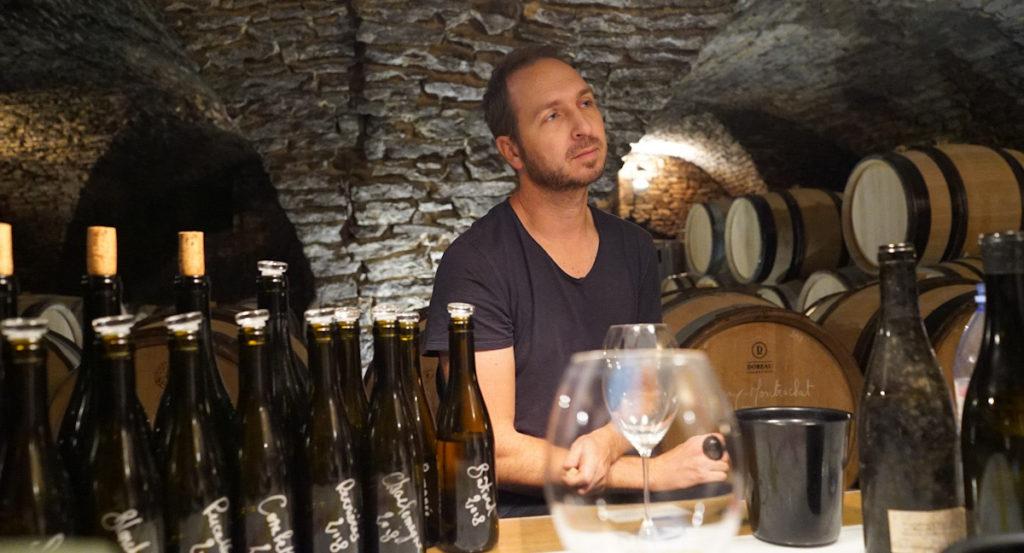Montrachet is a legendary vineyard, and while its boundaries have been defined since 1921, some neighbouring plots and parcels are more closely related to it than others.
Thibault Morey has two – no, three – plots located very close to the promised land. One is in Chassagne-Montrachet Les Blanchots Dessus, just a few meters south of Dominique Lafon’s Montrachet. The second is his Batard-Montrachet, located a wall- and road-width below Domaine Leflaive’s holding in the mythical vineyard.

Lastly is his Chassagne-Montrachet Dent de Chien, located just above Montrachet – only a few meters above, separated by a narrow road.
In fact, the Dent de Chien could have been a part of Montrachet if the decisions made in 1921 had played out differently – as could have been the Blanchots Dessus. So let’s take a closer look at the Dent de Chien – a plot that just missed inclusion in the 1921 expansion of Montrachet.
Montrachet now – and then
If one looks at old sources, the area and borders of the Montrachet vineyard were historically somewhat ambiguous. It was not until 1921 that Montrachet found its current size and boundaries.
Today, Montrachet is 7.998 ha, divided almost equally between Chassagne-Montrachet (3.9873 ha) and Puligny-Montrachet (4.0107 ha).
According to the literature, the size and borders were fixed in 1921 in a “legal decision” where some plots and areas were excluded from using the name “Montrachet,” whereas others were included in the so-called “Vrai Montrachet” vineyard – vrai meaning true – as opposed to Chevalier-Montrachet and Batard-Montrachet and so forth.
Before this decision, some plots outside the current Montrachet also used the name, apparently based on different historical definitions of the area “Montrachet.”
According to Lavalle,1 who quotes Claude Courtépé, even back in 1627 the terms Vrai Montrachet, Chevalier-Montrachet and Batard-Montrachet were used to describe different parts of the Montrachet area.
This explains in part the challenge different writers had when defining the vineyard in the early works. As Vrai Montrachet has always been considered the best and most expensive part of the area, owners have been always been keen to use that name when they sell their wines. It commanded a higher price.
This created an open door for disputes and different interpretations of the definition of Vrai Monrachet. Finally, in 1921, the issue was settled by a court ruling, ending what was presumably many decades of debate.
The court, however, was forced to examine some important questions in order to make its ruling: Which vineyards and plots (if any) were historically considered to be part of the famous Vrai Monrachet. Also – importantly – which were never really considered a part of Vrai Montrachet? One could get the impression that many plots were considered a part at some point – at least by some.
I have crunched numbers and looked at some old cadastre maps and books to take a closer look at these questions, and to see which areas and plots have been added to Montrachet over the years (see the full article here).
Let’s get geeky!
Montrachet according to Lavalle (1855)
Lavalle quantified the area of the Puligny side of Montrachet as 3.9530 ha, very close to its current size.
He was different, however, with the Chassagne side. Lavalle quote the area of Le Montrachet as 13.5390 ha, more than 9.5 ha larger than Chassagne’s current part of the appellation.
You need to login as a Premium subscriber to read the rest of this article. If you are not a Premium Subscriber, use the subscribe function and sign-up.

 - A true vin d’émotion – a Burgundy of passion
- A true vin d’émotion – a Burgundy of passion - A truly hedonistic wine – lively and enjoyable
- A truly hedonistic wine – lively and enjoyable - A vivacious wine for pure indulgance
- A vivacious wine for pure indulgance - A potential vin d´émotion - frais et léger
- A potential vin d´émotion - frais et léger